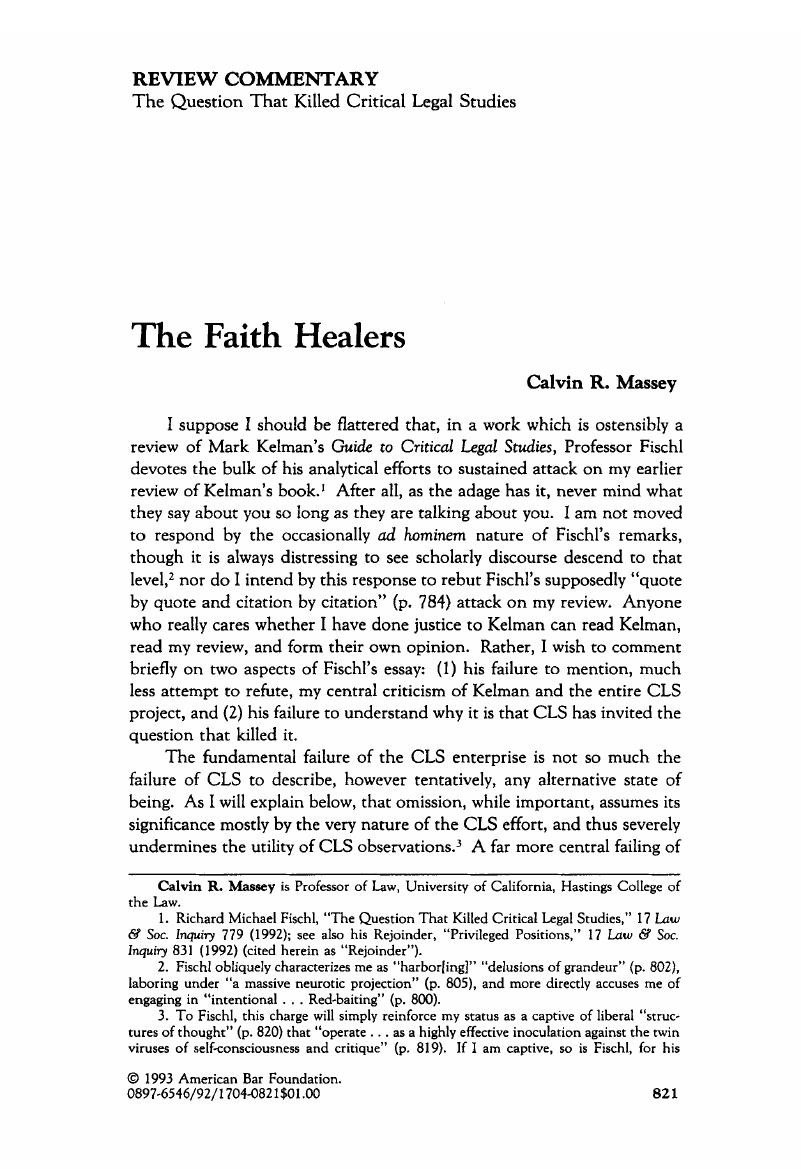No CrossRef data available.

1 Richard Michael Fischl, “The Question That Killed Critical Legal Studies,” 17 Law & Soc. Inquiry 779 (1992); see also his Rejoinder, “Privileged Positions,” 17 Law & Soc. Inquiry 831 (1992) (cited herein as “Rejoinder”).CrossRefGoogle Scholar
2 Fischl obliquely characterizes me as “harbor[ing]”“delusions of grandeur” (p. 802), laboring under “a massive neurotic projection” (p. 805), and more directly accuses me of engaging in “intentional … Red-baiting” (p. 800).Google Scholar
3 To Fischl, this charge will simply reinforce my status as a captive of liberal “structures of thought” (p. 820) that “operate … as a highly effective inoculation against the twin viruses of self-consciousness and critique” (p. 819). If I am captive, so is Fischl, for his hypothesis seems to be that our “thought structures” prevent us from the self-reflection that produces personal and societal transformation. Or perhaps I once again misunderstand, and it is the Crits who are freed from the straitjacket of “thought structures.” If so, I wonder how it is that Fischl can be so certain that he is exempt from the imprisonment of the mind that seems to addle me and the several billion other people who are not caught up in CLS “thought structures.”Google Scholar
4 Emphasis omitted; Mark Kelman, A Guide to Critical Legal Studies 13 (Cambridge, Mass.: Harvard University Press, 1987) (“Kelman, Guide”;).CrossRefGoogle Scholar
5 Id. at 4 (emphasis omitted).Google Scholar
6 Id. Google Scholar
7 Massey, Calvin R., “Law's Inferno,” 39 Hastings L.J. 1269, 1287 (1988).Google Scholar
8 Watts, Alan, The Way of Zen 175 (New York: Pantheon, 1957).Google Scholar
9 In early 19th-century Connecticut, two preachers from neighboring town—one a confirmed determinist and the other a disciple of free will—agreed to exchange pulpits. On the appointed Sunday they met each other on horseback halfway between their communities. The determinist greeted his opposite number with the observation that “ever since Creation, God has ordained that we exchange pulpits today.”Google Scholar
“Then I won't do it,” shouted the intentionalist, wheeling his horse around and spurring for home.Google Scholar
In his Rejoinder (pp. 831–32), Fischl clearly realizes that the tale is highly ambiguous but nevertheless attributes to the tale (at least so long as I am the storyteller) a damning preference for intentionalism. In so doing, Fischl reveals his preference for ascribing to his critics the views that provide convenient fodder for his argument. That gambit, of course, is precisely what he accuses me of doing.Google Scholar
10 ”‘What would you put in its place?’ Well, Mom, we can't answer that question and that's what's so weird about critical legal studies. We can't because the question itself presupposes virtually every assumption about law and legal scholarship that we are attempting to bring to the surface and to call into question” (p. 802).Google Scholar
11 Fischl p. 9, quoting Kelman, Guide 785.Google Scholar
12 Kelman, Guide 275 (emphasis Kelman's).Google Scholar
13 One of Fischl's favorite devices to stifle inquiry into the substance of the critical transformation is to accuse those who are skeptical of CLS of “dragging Stalin into it” (in Rejoinder, p. 837) or of “intentional … Red-baiting” (p. 800). This unsubtle equation of CLS skeptics with the inquisitors of the House Un-American Activities Committee may be a useful device to besmirch his critics, but Fischl conveniently ignores the infatuation of crits like Roberto Unger with the thoroughly brutal, vicious, and totalitarian politics and practices of the Red Guards of the Chinese Cultural Revolution. See Ewald, William, “Unger's Philosophy: A Critical Legal Study,” 97 Yale L.J. 665, 741–48 (1988).Google Scholar
14 Lasch, Christopher, The True and Only Heaven: Progress and Its Critics (New York: W. W. Norton & Co., 1991).Google Scholar
15 Glendon, Mary Ann, Rights Talk: The Impoverishment of Political Discourse x (New York: Free Press, 1991).Google Scholar
16 Id. Google Scholar
17 Id. at 106.Google Scholar
18 Id. Google Scholar
19 Id. at 106–7.Google Scholar
20 Id. at 107.Google Scholar
21 Mark Kelman, of course, authored one of the CLS movement's principal defenses of this gambit. See Kelman, Mark, “Trashing,” 36 Stan. L. Rev. 293 (1984).Google Scholar
22 In a single image, Fischl manages neatly to skewer loyalty, country music, and his critics by ridiculing our position as one in which we “Stand by Our Man, the self-determined autonomous subject” (Rejoinder, p. 835). If there was ever an illustration needed to explain to the crits why their ideas are dead on arrival on the doorstep of ordinary people, here it is.Google Scholar
23 Similarly, Fischl contends that I am of the view that “[e]ither human activity is intended or it is determined” (id.) and that there is no other possibility. One of the points of my earlier essay, repeated here, is that humans are simultaneously both intentionalists and determinists. Either Fischl fails to understand my point or he prefers to distort my views for the sake of scoring an argumentative coup.Google Scholar
24 See, e.g., Massey, 39 Hastings L.J. 1285 (cited in note 7).Google Scholar